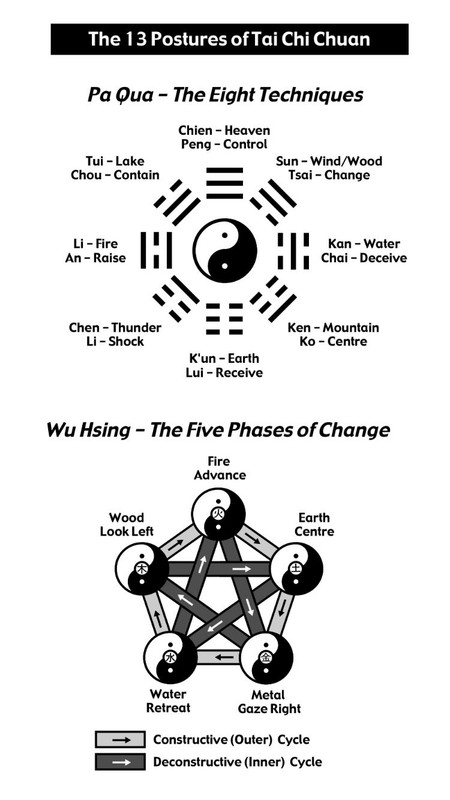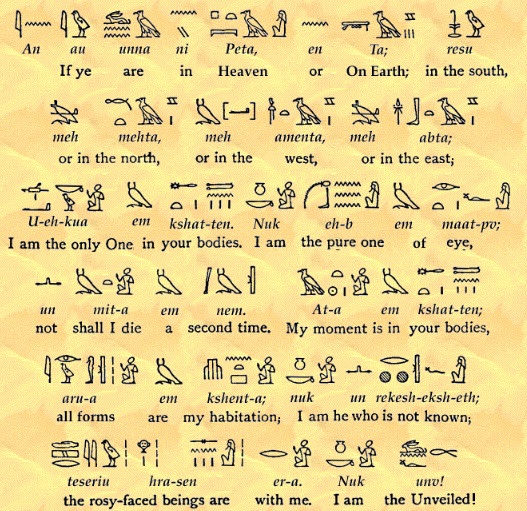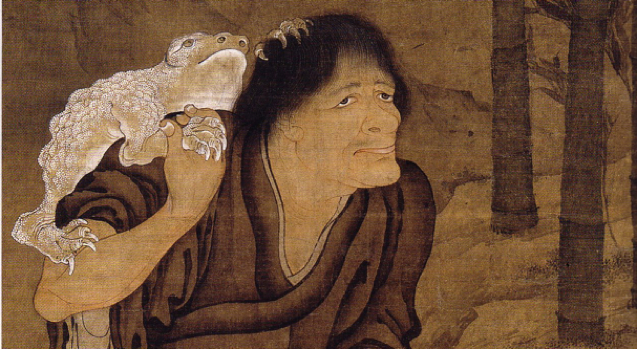The Bagua or Pakua are eight symbols used in Taoist cosmology to represent the fundamental principles of reality, seen as a range of eight interrelated concepts. Each consists of three lines, each line either "broken" or "unbroken", respectively representing yin or yang, 0 or 1 forming binary numbers 000-111 (0 to 7). Due to their tripartite structure, they are often referred to as Eight Trigrams in English.
The trigrams are related to Taiji philosophy, Taijiquan and the Wuxing, or "five elements". The relationships between the trigrams are represented in two arrangements, the Primordial (先天八卦), "Earlier Heaven" or "Fu Xi" bagua (伏羲八卦), and the Manifested (後天八卦), "Later Heaven," or "King Wen" bagua. The trigrams have correspondences in astronomy, astrology, geography, geomancy, anatomy, the family, martial arts and elsewhere.
The ancient Chinese classic, I Ching (Pinyin: Yi Jing), consists of the 64 pairwise permutations of trigrams, referred to as "hexagrams", along with commentary on each one.

Many philosophies and traditions around the world believe in similar elements. They tend to focus on about five specific ones. Here is a look at the five elements in Chinese, Japanese, Buddhist, Greek, Babylonian, and European alchemy.
Babylonian 5 Elements
wind
fire
earth
sea
sky
Medieval Alchemy
The number of traditional elements in medieval alchemy varies from 4, 5, or 8. The first four are always found. The fifth, aether, is important in some traditions. Sulfur, mercury, and salt are classical elements.
air
fire
water
earth
aether
sulfur
mercury
salt
Greek 5 Elements
air
water
fire
earth
aether
Chinese 5 Elements - Wu Xing
wood
water
earth
fire
metal
Japanese 5 Elements - Godai
air
water
earth
fire
void
Hindu and Buddhist 5 Elements
Akasha is the equivalent to Aristotle's aether, in the Greek tradition. While Hinduism traditionally recognizes five elements, Buddhism typically only the first four "great" or "gross" elements. Although the names are different, the first four elements roughly translate as being air, fire, water, and earth.
Vayu (wind or air)
Ap (water)
Agni fire)
Prithvi (earth)
Akasha
Tibetan 5 Elements (Bon)
air
water
earth
fire
aether
Helmenstine, Anne Marie, Ph.D. "What Are the 5 Traditional Elements?" ThoughtCo, Aug. 28, 2020, thoughtco.com/what-are-the-5-traditional-elements-607743.
By Anne Marie Helmenstine, Ph.D.
Updated August 12, 2019


Note: The binary marks below in the bagua represent a sort of "on/off" switch. There are three lines in the number. If the line is broken, that position represents zero. If the line is solid, it is one. Fire is 101 (five in binary code) and water is 010 (2 in binary). But when you combine the two into a six digit number, you get 101010 (binary for 42). It's possible, and I would even say likely, that this explains the importance of the number 42 to ancient Egyptians.

Taoist and Chinese alchemist pictured creating steam/water vapor using the trandional elements fire and water, the creation of tea.






The Three Treasures
Main article: Three Treasures (traditional Chinese medicine)
Internal alchemy focuses upon transforming the bodily sanbao "three treasures", which are the essential energies sustaining human life:
Jing 精 "nutritive essence, essence; refined, perfected; extract; spirit, demon; sperm, seed"
Qi 氣 "vitality, energy, force; air, vapor; breath; spirit, vigor; attitude"
Shen 神 "spirit; soul, mind; god, deity; supernatural being"
According to the 13th-century Book of Balance and Harmony:
Making one's essence complete, one can preserve the body. To do so, first keep the body at ease, and make sure there are no desires. Thereby energy can be made complete. Making one's energy complete, one can nurture the mind. To do so, first keep the mind pure, and make sure there are no thoughts. Thereby spirit can be made complete. Making one's spirit complete, one can recover emptiness. To do so, first keep the will sincere, and make sure body and mind are united. Thereby spirit can be returned to emptiness. ... To attain immortality, there is nothing else but the refinement of these three treasures: essence, energy, spirit." (tr. Kohn 1956, 146). When the "three treasures" are internally maintained, along with a balance of yin and yang, it is possible to achieve a healthy body and longevity, which are the main goals of internal alchemy (Ching 1996, 395).
Jing
Neidan practice
Jing "essence" referring to the energies of the physical body. Based upon the idea that death was caused by depleting one's jing, Daoist internal alchemy claimed that preserving jing allowed one to achieve longevity, if not immortality. (Schipper 1993, 154).
Qi
Qi or ch'i is defined as the "natural energy of the universe" and manifests in everyone and everything (Carroll 2008). By means of internal alchemy, Taoists strive to obtain a positive flow of qi through the body in paths moving to each individual organ (Smith 1986, 201).
Healing practices such as acupuncture, massage, cupping and herbal medicines are believed to open up the qi meridians throughout the body so that the qi can flow freely. Keeping qi in balance and flowing throughout the body promotes health; imbalance can lead to sickness.
Shen
Shen is the original spirit of the body. Taoists try to become conscious of shen through meditation (Smith 1986, 202).

“Golden Elixir is another name for one’s fundamental nature. There is no other Golden Elixir outside one's fundamental nature. All human beings have this Golden Elixir complete in themselves: it is entirely realized in everybody. It is neither more in a sage, nor less in an ordinary person. It is the seed of the Immortals and the Buddhas, the root of the worthies and the sages.”
Liu Yiming (1734-1821)

No comments:
Post a Comment
Note: Only a member of this blog may post a comment.